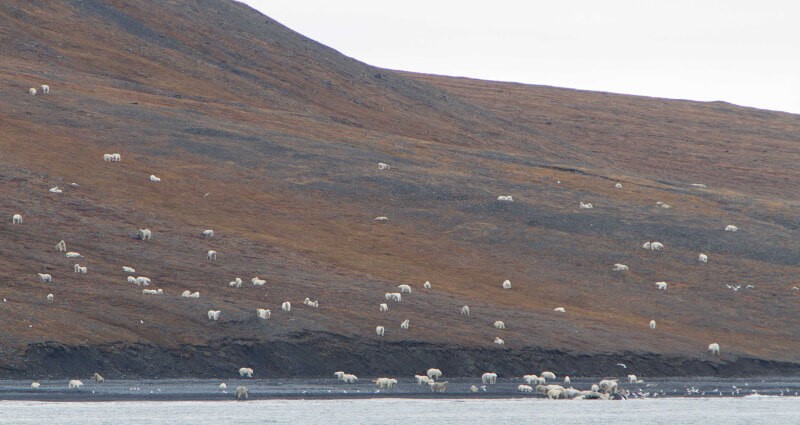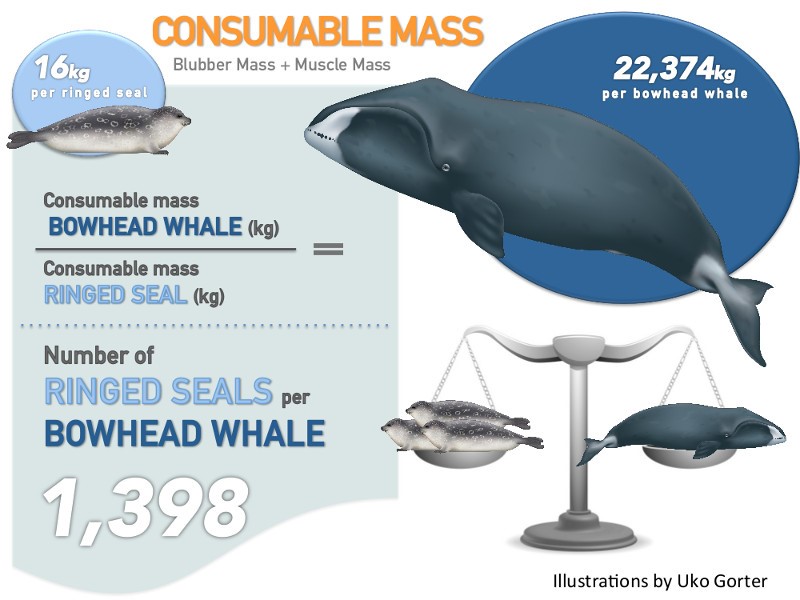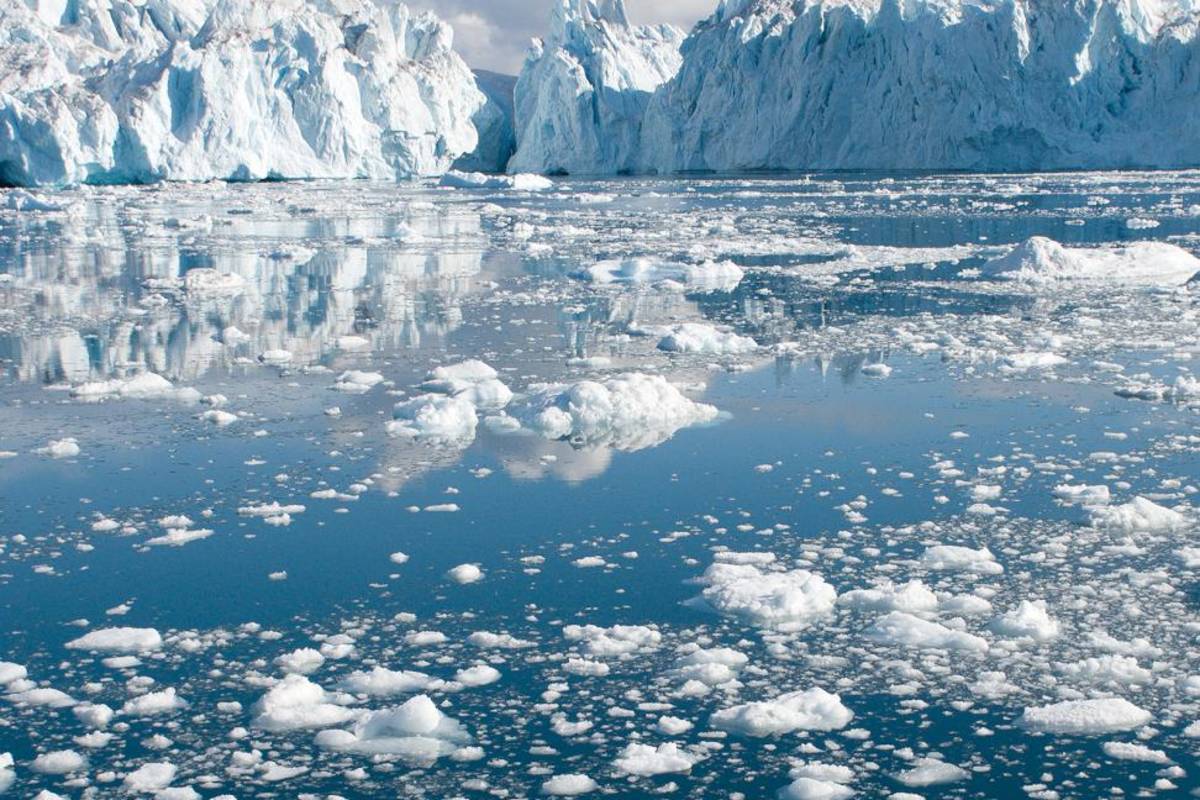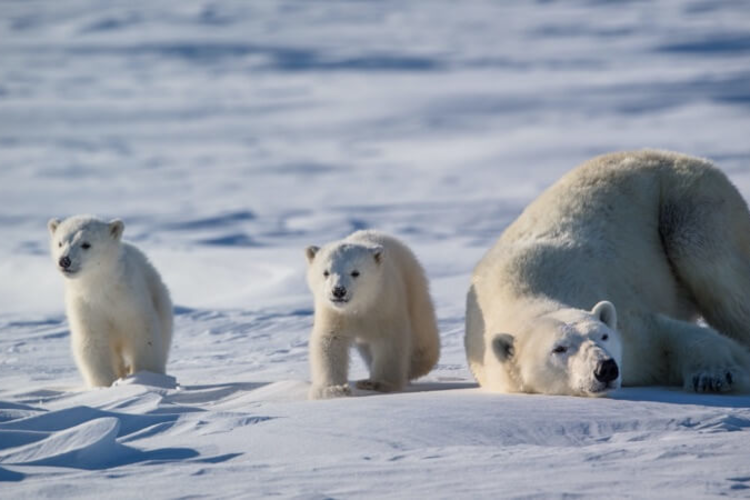It is well known that polar bears need to use sea ice as a platform from which to hunt seals because they can’t catch them in the open water. However, as the climate continues to warm the Arctic, the sea ice is breaking up earlier in the spring and freezing later in the fall. This means that the most important seal-hunting period of the year for the bears (late spring and early summer) is getting progressively shorter. The consequence of that for the bears, especially in areas with seasonal sea ice cover such as the western coast of Hudson Bay, is that they are now having to fast for progressively longer periods on smaller stored fat reserves while they wait on shore for the ice to freeze again so they can return to hunting. As the open water period has become longer over time, pregnant adult females have also been in poorer body condition before they start to den, are producing fewer cubs, and those cubs are not surviving as well as in the past.
Now, because of continued climate warming, a lack of sea ice in summer throughout the Arctic has been predicted to occur within the next few decades. Not surprisingly, concerns are being expressed for the long-term survival of polar bears in the wild because, if the bears lose much or all the sea ice on a year-round basis, they will be forced ashore for increasingly long periods, where they cannot simply adapt to terrestrial food sources.
Polar bears have evolved over a long period of time to live on fat-rich diets and cannot survive by eating plants, like brown or black bears can. However, because polar bears evolved from brown (grizzly) bears about 500,000 years ago, it is clear that they must have survived at least three or four warm and largely ice-free interglacial periods in the past, including the most well-known and warmest interglacial, the Eemian (130-115 thousand years ago!). Not surprisingly then, the big question people quite reasonably keep asking is: How did polar bears survive with little or no sea ice in the past and, could they do so again, until humans are able to slow and possibly reverse climate warming?
Clues on today’s shores
An obvious starting point is to consider is: Are there any possible alternative food sources that are very rich in fat that might be available to polar bears stuck on land for long periods? When you stop to think about it, the hints about a possible answer to that question are already visible on Arctic shorelines every year. The carcasses of large baleen whales that die of natural causes and wash up on beaches in different parts of the Arctic are well known to attract large numbers of bears to feed on them, often for durations of a year or more. In past warm interglacial periods, long before the slaughters of the commercial whaling period, the numbers of large whales of several species living in the open and biologically productive polar oceans would have numbered in the hundreds of thousands, or possibly even millions, compared with just a few tens of thousands at the most today. Most whales, of course, die at sea and their carcasses sink, where they would be inaccessible to polar bears on land. However, roughly 10% of naturally dying whales become buoyant as a result of gas in the body cavity generated by decomposition of body tissues while they are drifting at sea. Some of these carcasses would have washed up on beaches in the Arctic where they could have been fed upon by any bears in the area.

Figure 1. Some of the more than 180 bears recorded feeding on a single bowhead whale carcass on Wrangel Island, Chukotka, Russia, in September 2017. (© O. Belonovich/Heritage Expeditions)
Several times in recent years, substantial numbers of polar bears have been observed feeding on large bowhead and gray whale carcasses. In 2017, more than 180 bears were seen scavenging on a single dead bowhead whale washed ashore on Wrangel Island in Russia (Figure 1). Moreover, individual bears may return to the remains of the same carcass for a year or more, as illustrated by bears feeding on a fin whale carcass in a small bay on the western coast of Svalbard (Norway) a few years ago (Figure 2a-c).

Figure 2. Polar bears may scavenge on large whale carcasses for over a year, as shown in this series of images taken in Svalbard. (a) Four males stand on the floating carcass of a fin whale (Balaenoptera physalus) (© Daniel J. Cox/Arctic Documentary Project); (b) 2 months later, the same carcass being fed on by six males and an unknown total number of bears throughout the following winter (© Norbert Rosing); (c) 1 year later, most of the carcass had been consumed but the remains, despite being largely submerged, were still being used by several bears, including this adult female and cub (© Ian Stirling).
When you consider that each polar bear in a population may require about 43 ringed seals, or ringed seal equivalents, every year (more for big bears, fewer for small bears) then the importance of just one large bowhead whale carcass to hungry polar bears is huge (Figure 3).

Uko Gorter
Figure 3: Calculation of the value of the blubber and muscle mass of an adult bowhead whale carcass to polar bears, as measured in ringed seal equivalents
Different story today
The presence of polar bear populations throughout the circumpolar Arctic today makes it clear that polar bears persisted successfully through several previous low-ice interglacial periods that resulted from naturally occurring climate cycles. The most likely explanation available to date seems to be that polar bears likely survived primarily by scavenging on whale (or other marine mammal) carcasses which, considering the large populations that must have been abundant in the Arctic before the arrival of humans, may have occurred relatively frequently in areas where prevailing winds or sea currents brought them to the coast. The polar bears in areas where whale carcasses washed up probably ate and stored large amounts of fat from them in order to survive periods when hunting seals was not an option.
However, when we look at the present situation in the Arctic marine ecosystem, with respect to possible alternative food sources for polar bears if they were largely unable to hunt seals, it’s a very different picture. Whale carcasses may still be important in a few areas but, quite simply, the potential overall availability of carcasses to scavenge on is substantially less than was likely the case before commercial whalers arrived in the Arctic, devastated many of the whale populations, and, later, developed large-scale offshore industrial and shipping activities.
Of equal overall importance though, the potential ability of whale carcasses to help polar bears survive in a future relatively ice-free Arctic will not only depend on a supply of carcasses over time but also that they recur reliably in predictable locations. For example, the present-day healthy populations of gray and bowhead whale populations offshore from the coasts of Chukotka (Russia) and Alaska produced an average of about 11 large whale carcasses between June and November each year from 1963-1993. Clearly, the predictable amounts and locations of whale carcasses, potentially augmented by lesser amounts of dead walruses and other seals, still has the potential to significantly augment the diet of polar bears in the area for some time. In contrast, in recent years, variable but small numbers of whale carcasses are periodically stranded on the western and northern coasts of Svalbard, after being transported there from the North Atlantic via the Gulf Stream.
The diet of resident polar bears may be augmented by these carcasses but, because carcass numbers are low and the locations where they are deposited are less predictable, their potential value to supporting a polar bear population at present is fairly low. Thus, even though whale carcasses will always be important for scavenging polar bears wherever they wash ashore, they are not expected to be able to replace seals as the nutritional resources for the circumpolar population of polar bears as we move towards an ice-free Arctic. In most regions, the environmental changes are too large and the whale carcasses too few. In summary then, although it appears that whale carcasses may have helped polar bears persist through previous warm periods, the only real solution for the conservation of polar bears throughout the circumpolar Arctic now is to slow and ultimately stop climate warming.
Dr. Ian Stirling is a research scientist emeritus with Environment and Climate Change Canada and an adjunct professor with the Department of Biological Sciences, University of Alberta. Dr. Kristin Laidre is a research scientist at the Polar Science Center, Applied Physics Lab, University of Washington.
















